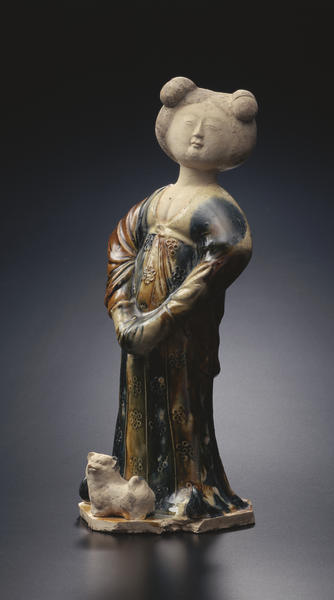宮女俑
- 中国 唐時代
- 8世紀初期
- 三彩陶
作品全体にのんびりとした典雅な風情が漂う唐三彩である。婦人は豊満な姿で表され、まさに唐代美人の例に倣ったといえる。肩パット付きの上着のデコルテが大きく開き、その上から?というショールを羽織る。縦縞に型押しの七曜紋を施した長裾をはき、尖った沓のつま先を裳から現す。左後方にやや身体を反らせ、足下にはチンに似た小型犬が寄り添う。婦人は頭髪を双髻に結い、あたかも愛犬の面貌を映したようで微笑ましい。また花鈿装飾は当時流行した化粧であり、唇には朱が残る。唐三彩は初唐末期に始まり、盛唐期の長安・洛陽における貴族の厚葬の風習にともなって大流行した明器である。この俑でも衣裳全体に藍・褐色・緑・白の釉薬を流している。また婦人の頭髪・眉・目と犬の毛は墨で表されている。
Catalogue Entry
Brimming with relaxed elegance, this example of Tang “tricolor” ceramic figurines shows the type of plump-fleshed woman that epitomized the period’s ideal of feminine beauty. She wears a robe with shoulder pads and a decollete low neckline, over which is wrapped a kind of shawl called a pei. Her long-skirted garment is decorated with vertical stripes and stamped seven-star crests, and the tips of pointy shoes jut out from under her hem. Her upper body leans slightly back and to the left, and nestling at her feet is a small dog. With her hair done up in two buns, the woman’s expression charmingly resembles that of her pet. A style of makeup known as huadian was popular in China at that time, and traces of vermilion remain on the figure’s lips. Tang tricolor wares first appeared at the end of the Early Tang period (ca. 618-710), and became popular as grave goods as the custom of lavish funerals took hold among aristocrats in Chang’an and Luoyang during the High Tang period (ca. 711-763). The clothing of the figurine is covered entirely in glazes of indigo, brown, green, and white, and the woman’s hair, eyebrows, and eyes, as well as the dog’s hair, are painted with sumi ink.
